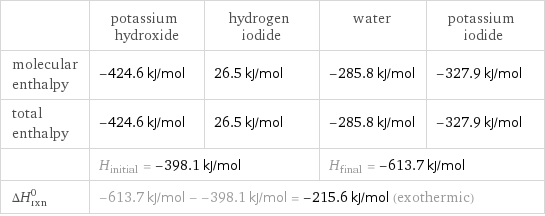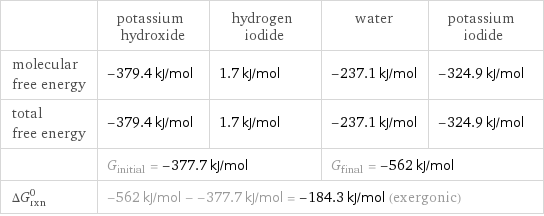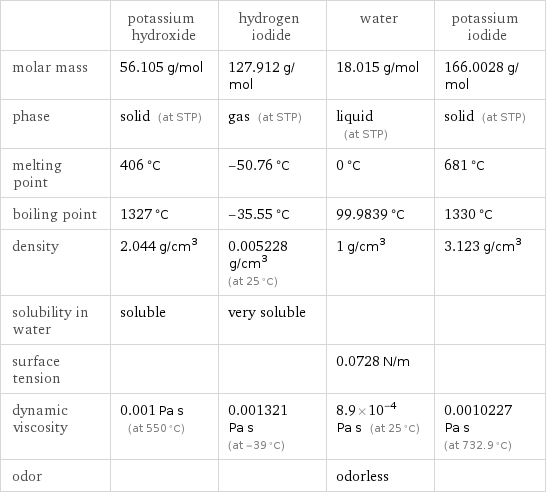Input interpretation

KOH potassium hydroxide + HI hydrogen iodide ⟶ H_2O water + KI potassium iodide
Balanced equation

Balance the chemical equation algebraically: KOH + HI ⟶ H_2O + KI Add stoichiometric coefficients, c_i, to the reactants and products: c_1 KOH + c_2 HI ⟶ c_3 H_2O + c_4 KI Set the number of atoms in the reactants equal to the number of atoms in the products for H, K, O and I: H: | c_1 + c_2 = 2 c_3 K: | c_1 = c_4 O: | c_1 = c_3 I: | c_2 = c_4 Since the coefficients are relative quantities and underdetermined, choose a coefficient to set arbitrarily. To keep the coefficients small, the arbitrary value is ordinarily one. For instance, set c_1 = 1 and solve the system of equations for the remaining coefficients: c_1 = 1 c_2 = 1 c_3 = 1 c_4 = 1 Substitute the coefficients into the chemical reaction to obtain the balanced equation: Answer: | | KOH + HI ⟶ H_2O + KI
Structures

+ ⟶ +
Names

potassium hydroxide + hydrogen iodide ⟶ water + potassium iodide
Reaction thermodynamics
Enthalpy

| potassium hydroxide | hydrogen iodide | water | potassium iodide molecular enthalpy | -424.6 kJ/mol | 26.5 kJ/mol | -285.8 kJ/mol | -327.9 kJ/mol total enthalpy | -424.6 kJ/mol | 26.5 kJ/mol | -285.8 kJ/mol | -327.9 kJ/mol | H_initial = -398.1 kJ/mol | | H_final = -613.7 kJ/mol | ΔH_rxn^0 | -613.7 kJ/mol - -398.1 kJ/mol = -215.6 kJ/mol (exothermic) | | |
Gibbs free energy

| potassium hydroxide | hydrogen iodide | water | potassium iodide molecular free energy | -379.4 kJ/mol | 1.7 kJ/mol | -237.1 kJ/mol | -324.9 kJ/mol total free energy | -379.4 kJ/mol | 1.7 kJ/mol | -237.1 kJ/mol | -324.9 kJ/mol | G_initial = -377.7 kJ/mol | | G_final = -562 kJ/mol | ΔG_rxn^0 | -562 kJ/mol - -377.7 kJ/mol = -184.3 kJ/mol (exergonic) | | |
Equilibrium constant
![Construct the equilibrium constant, K, expression for: KOH + HI ⟶ H_2O + KI Plan: • Balance the chemical equation. • Determine the stoichiometric numbers. • Assemble the activity expression for each chemical species. • Use the activity expressions to build the equilibrium constant expression. Write the balanced chemical equation: KOH + HI ⟶ H_2O + KI Assign stoichiometric numbers, ν_i, using the stoichiometric coefficients, c_i, from the balanced chemical equation in the following manner: ν_i = -c_i for reactants and ν_i = c_i for products: chemical species | c_i | ν_i KOH | 1 | -1 HI | 1 | -1 H_2O | 1 | 1 KI | 1 | 1 Assemble the activity expressions accounting for the state of matter and ν_i: chemical species | c_i | ν_i | activity expression KOH | 1 | -1 | ([KOH])^(-1) HI | 1 | -1 | ([HI])^(-1) H_2O | 1 | 1 | [H2O] KI | 1 | 1 | [KI] The equilibrium constant symbol in the concentration basis is: K_c Mulitply the activity expressions to arrive at the K_c expression: Answer: | | K_c = ([KOH])^(-1) ([HI])^(-1) [H2O] [KI] = ([H2O] [KI])/([KOH] [HI])](../image_source/f089eacd46d500f5726cf2c71467fbc7.png)
Construct the equilibrium constant, K, expression for: KOH + HI ⟶ H_2O + KI Plan: • Balance the chemical equation. • Determine the stoichiometric numbers. • Assemble the activity expression for each chemical species. • Use the activity expressions to build the equilibrium constant expression. Write the balanced chemical equation: KOH + HI ⟶ H_2O + KI Assign stoichiometric numbers, ν_i, using the stoichiometric coefficients, c_i, from the balanced chemical equation in the following manner: ν_i = -c_i for reactants and ν_i = c_i for products: chemical species | c_i | ν_i KOH | 1 | -1 HI | 1 | -1 H_2O | 1 | 1 KI | 1 | 1 Assemble the activity expressions accounting for the state of matter and ν_i: chemical species | c_i | ν_i | activity expression KOH | 1 | -1 | ([KOH])^(-1) HI | 1 | -1 | ([HI])^(-1) H_2O | 1 | 1 | [H2O] KI | 1 | 1 | [KI] The equilibrium constant symbol in the concentration basis is: K_c Mulitply the activity expressions to arrive at the K_c expression: Answer: | | K_c = ([KOH])^(-1) ([HI])^(-1) [H2O] [KI] = ([H2O] [KI])/([KOH] [HI])
Rate of reaction
![Construct the rate of reaction expression for: KOH + HI ⟶ H_2O + KI Plan: • Balance the chemical equation. • Determine the stoichiometric numbers. • Assemble the rate term for each chemical species. • Write the rate of reaction expression. Write the balanced chemical equation: KOH + HI ⟶ H_2O + KI Assign stoichiometric numbers, ν_i, using the stoichiometric coefficients, c_i, from the balanced chemical equation in the following manner: ν_i = -c_i for reactants and ν_i = c_i for products: chemical species | c_i | ν_i KOH | 1 | -1 HI | 1 | -1 H_2O | 1 | 1 KI | 1 | 1 The rate term for each chemical species, B_i, is 1/ν_i(Δ[B_i])/(Δt) where [B_i] is the amount concentration and t is time: chemical species | c_i | ν_i | rate term KOH | 1 | -1 | -(Δ[KOH])/(Δt) HI | 1 | -1 | -(Δ[HI])/(Δt) H_2O | 1 | 1 | (Δ[H2O])/(Δt) KI | 1 | 1 | (Δ[KI])/(Δt) (for infinitesimal rate of change, replace Δ with d) Set the rate terms equal to each other to arrive at the rate expression: Answer: | | rate = -(Δ[KOH])/(Δt) = -(Δ[HI])/(Δt) = (Δ[H2O])/(Δt) = (Δ[KI])/(Δt) (assuming constant volume and no accumulation of intermediates or side products)](../image_source/364a93d8f3f069d1450dd43f99bf47d9.png)
Construct the rate of reaction expression for: KOH + HI ⟶ H_2O + KI Plan: • Balance the chemical equation. • Determine the stoichiometric numbers. • Assemble the rate term for each chemical species. • Write the rate of reaction expression. Write the balanced chemical equation: KOH + HI ⟶ H_2O + KI Assign stoichiometric numbers, ν_i, using the stoichiometric coefficients, c_i, from the balanced chemical equation in the following manner: ν_i = -c_i for reactants and ν_i = c_i for products: chemical species | c_i | ν_i KOH | 1 | -1 HI | 1 | -1 H_2O | 1 | 1 KI | 1 | 1 The rate term for each chemical species, B_i, is 1/ν_i(Δ[B_i])/(Δt) where [B_i] is the amount concentration and t is time: chemical species | c_i | ν_i | rate term KOH | 1 | -1 | -(Δ[KOH])/(Δt) HI | 1 | -1 | -(Δ[HI])/(Δt) H_2O | 1 | 1 | (Δ[H2O])/(Δt) KI | 1 | 1 | (Δ[KI])/(Δt) (for infinitesimal rate of change, replace Δ with d) Set the rate terms equal to each other to arrive at the rate expression: Answer: | | rate = -(Δ[KOH])/(Δt) = -(Δ[HI])/(Δt) = (Δ[H2O])/(Δt) = (Δ[KI])/(Δt) (assuming constant volume and no accumulation of intermediates or side products)
Chemical names and formulas

| potassium hydroxide | hydrogen iodide | water | potassium iodide formula | KOH | HI | H_2O | KI Hill formula | HKO | HI | H_2O | IK name | potassium hydroxide | hydrogen iodide | water | potassium iodide
Substance properties

| potassium hydroxide | hydrogen iodide | water | potassium iodide molar mass | 56.105 g/mol | 127.912 g/mol | 18.015 g/mol | 166.0028 g/mol phase | solid (at STP) | gas (at STP) | liquid (at STP) | solid (at STP) melting point | 406 °C | -50.76 °C | 0 °C | 681 °C boiling point | 1327 °C | -35.55 °C | 99.9839 °C | 1330 °C density | 2.044 g/cm^3 | 0.005228 g/cm^3 (at 25 °C) | 1 g/cm^3 | 3.123 g/cm^3 solubility in water | soluble | very soluble | | surface tension | | | 0.0728 N/m | dynamic viscosity | 0.001 Pa s (at 550 °C) | 0.001321 Pa s (at -39 °C) | 8.9×10^-4 Pa s (at 25 °C) | 0.0010227 Pa s (at 732.9 °C) odor | | | odorless |
Units
